Abstract
Two plaque morphology BK virus (BKV) mutants (pm526 and pm527) rescued from a hamster pineocytoma cell line Pc13 were characterized and compared with a similarly rescued and previously characterized mutant (pm522), its derivatives (tr530, tr531, and tr532), and the wild type (501) for their biological activities and for the structures of their transcriptional control regions. The two mutants grew somewhat more slowly in human embryonic kidney cells but transformed rat 3Y1 cells more efficiently than did the wild-type BKV. BKV pm526 formed minute plaques and had the shortest transcriptional control region, having only one 68-base-pair element, which is triplicated in the wild-type BKV. BKV pm526 was unstable during repeated replication in human embryonic kidney cells and yielded large-plaque viruses with longer HindIII C segments encompassing the BKV DNA replication origin. Comparison of nucleotide sequences of the transcriptional control regions among the mutants and the wild type showed that pm526 is a parent virus, from which all the other mutants had evolved, and that the evolutionary changes of the plaque size, from minute to small to large, were due to duplications of a certain segment containing the adenovirus E1A enhancer core or the simian virus 40 enhancer core found in the BKV 68-base-pair element. The activities to enhance early transcription, as measured by the ability to direct the synthesis of chloramphenicol acetyltransferase, approximately paralleled the plaque size. The duplication containing the adenovirus E1A enhancer core did not affect the transforming capacity of the parent virus, but the duplication including the simian virus 40 enhancer core significantly lowered the transforming capacity for rat cells.
Full text
PDF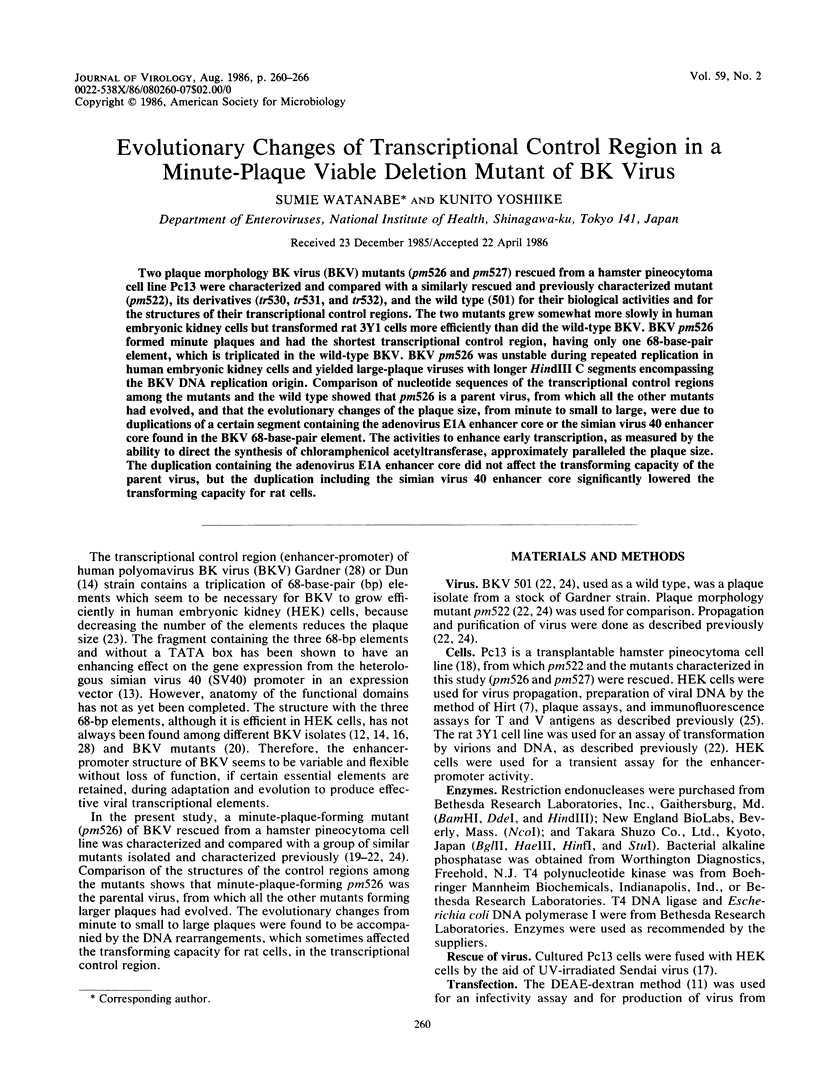
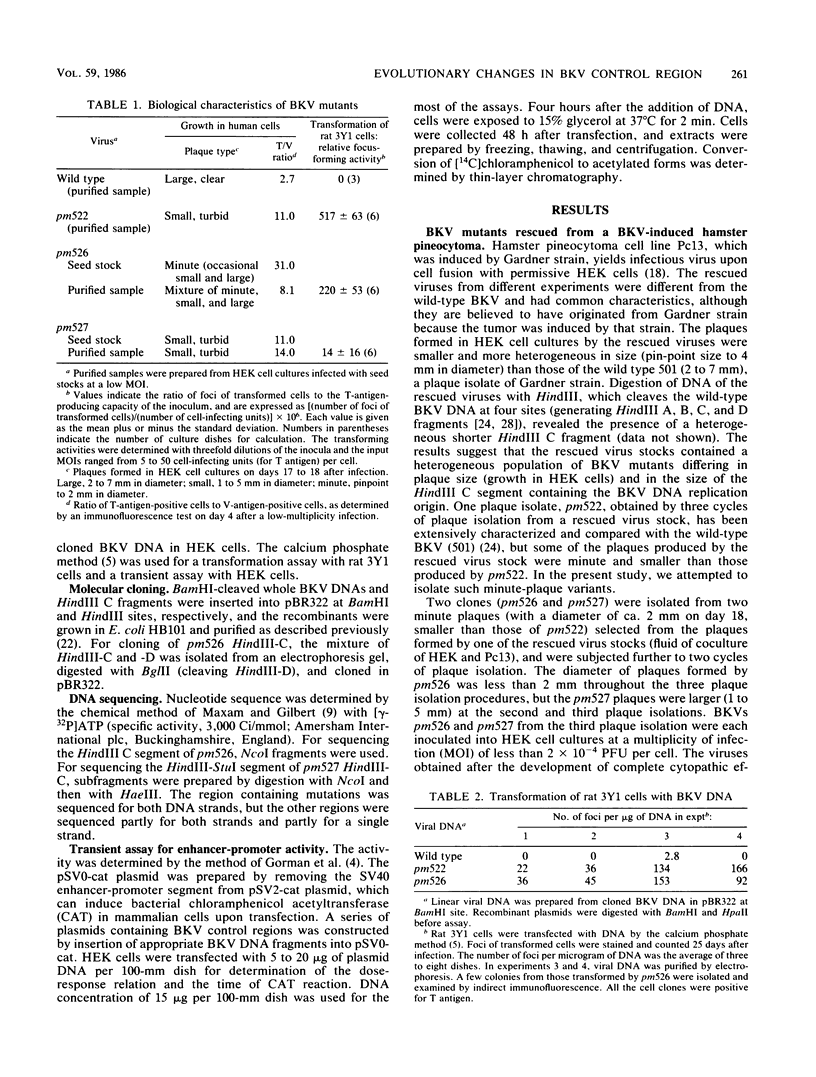
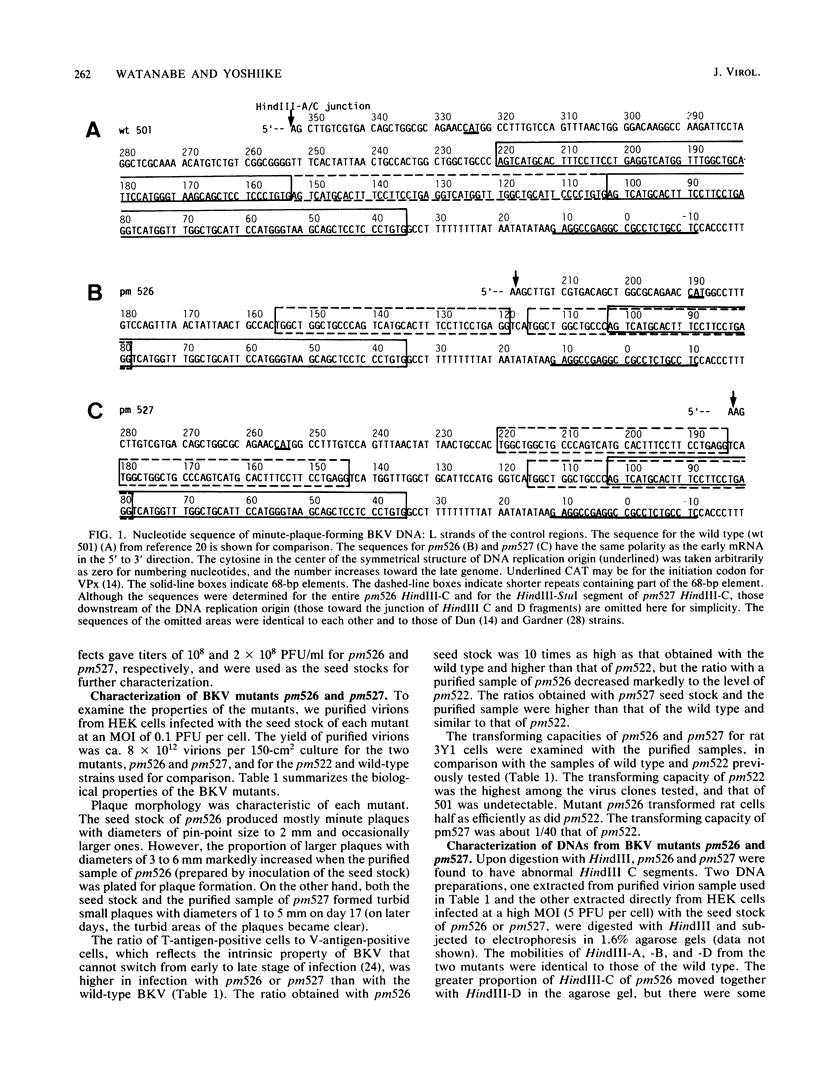
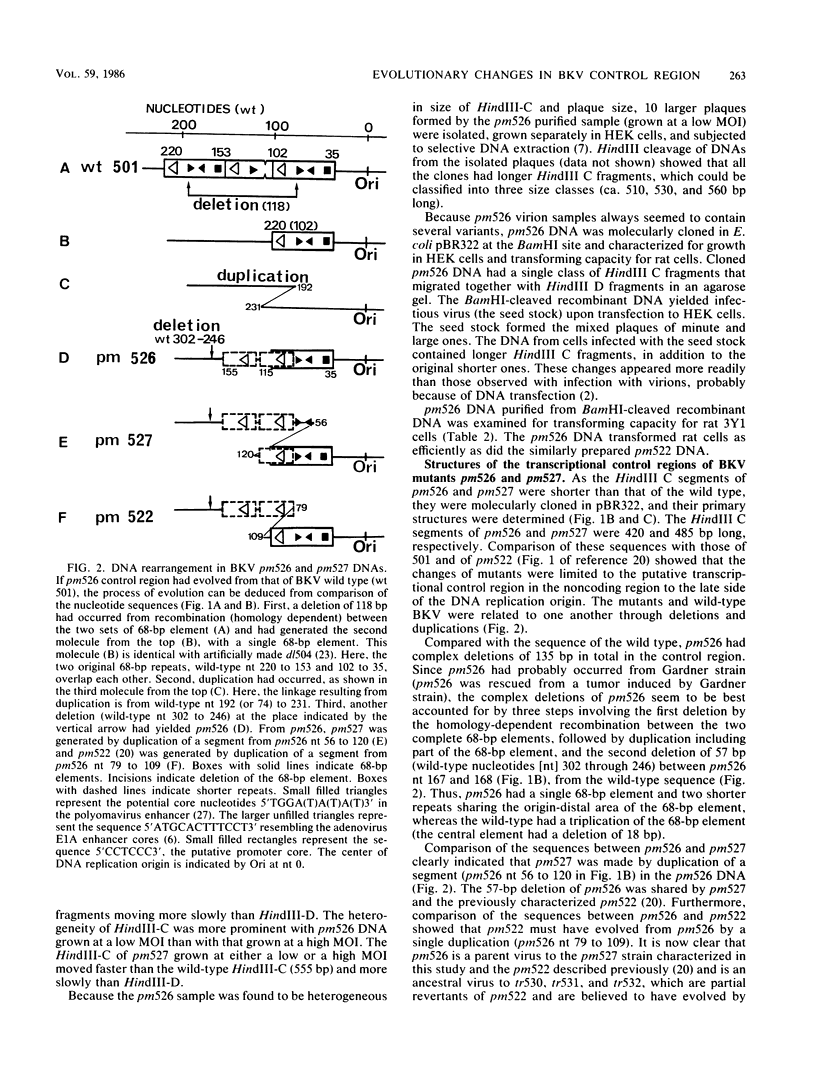
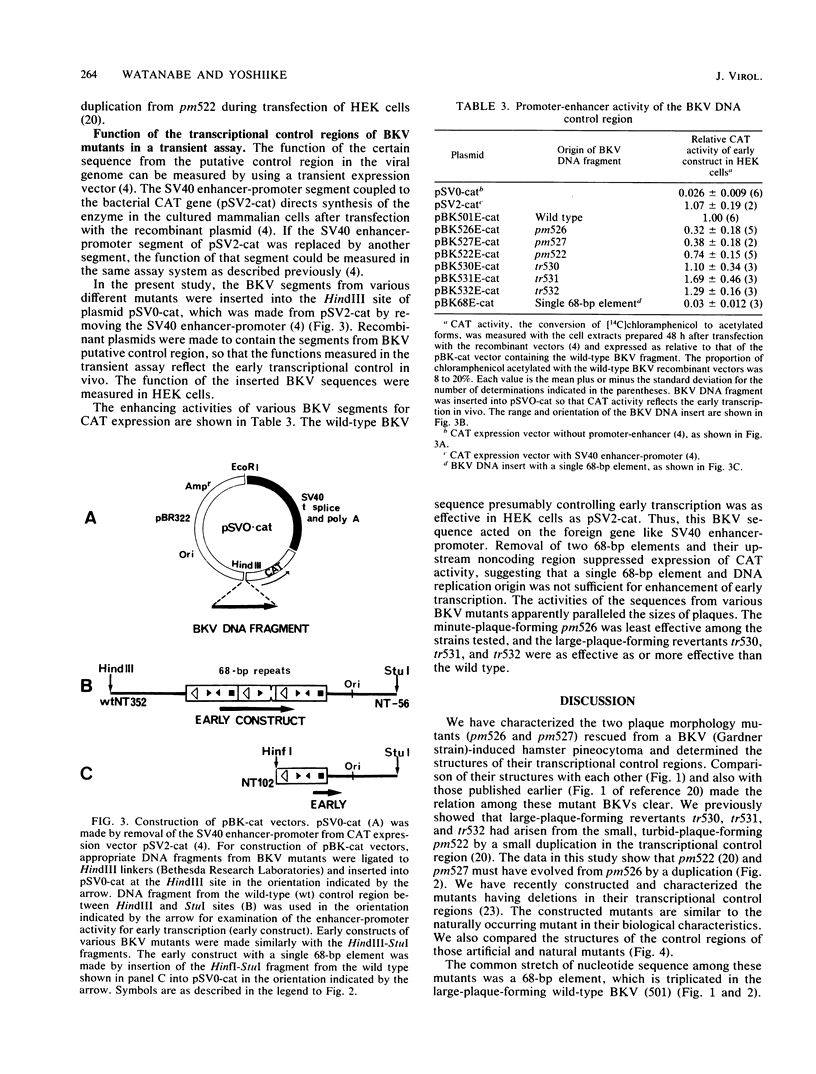
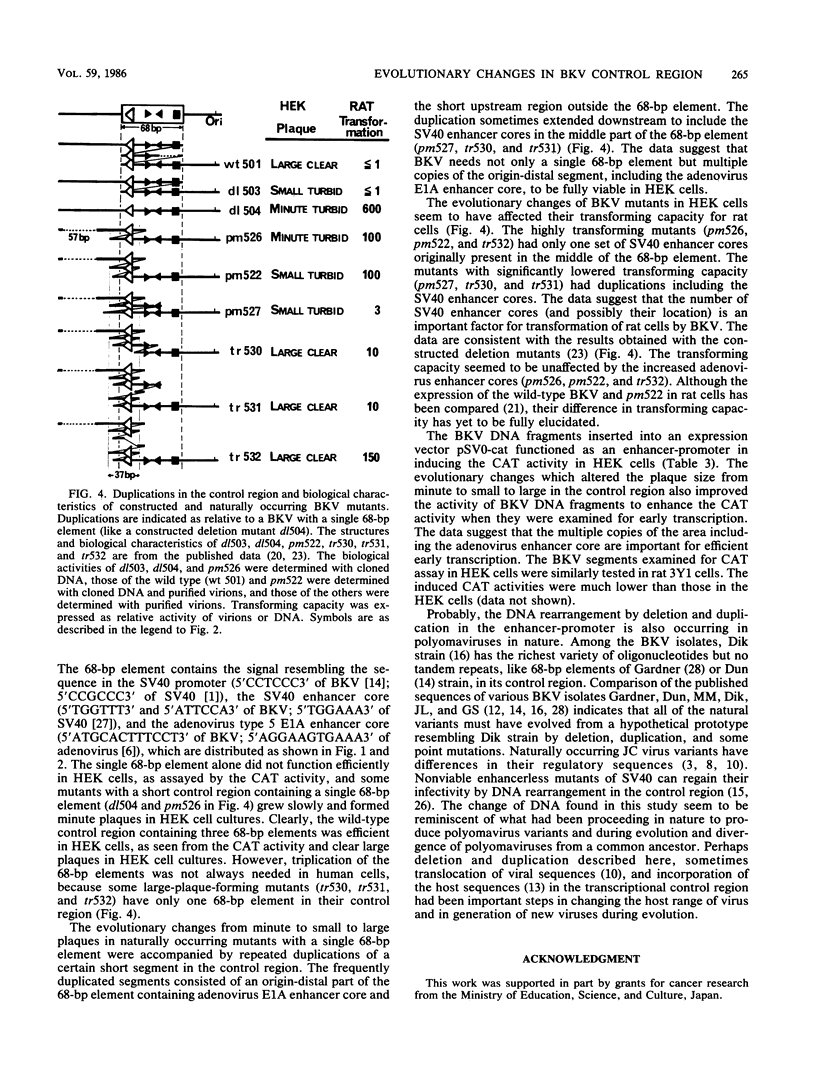
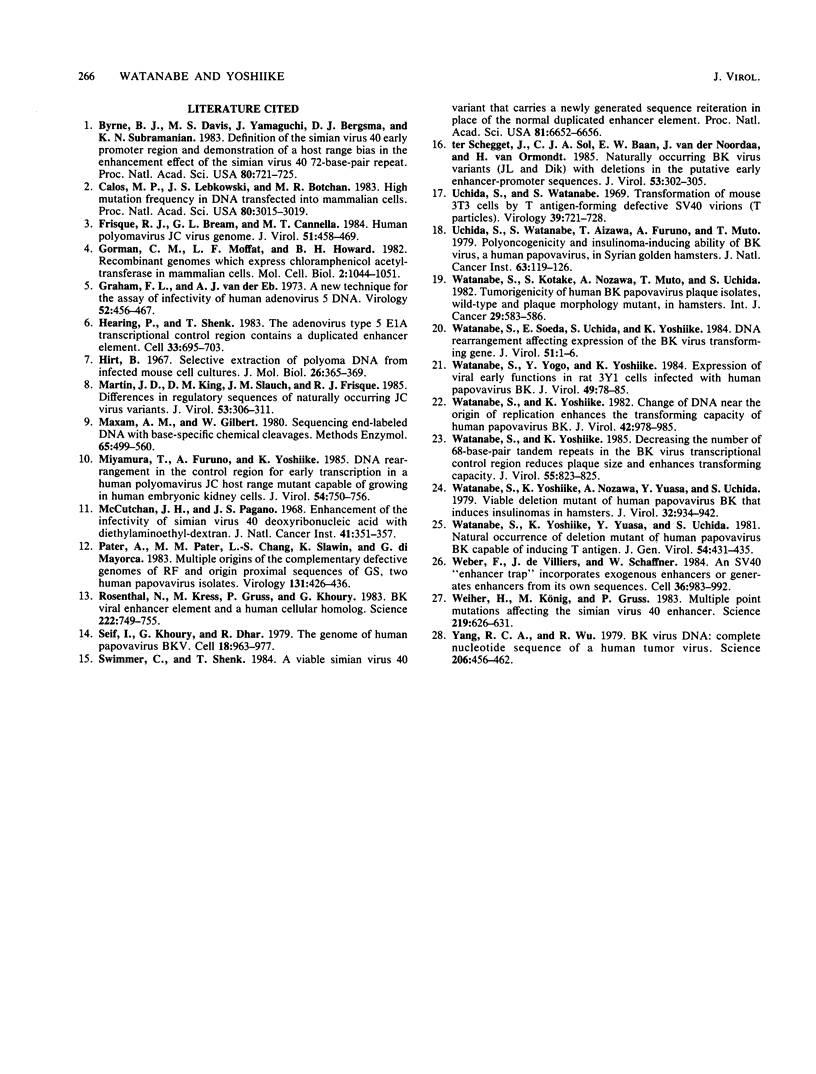
Selected References
These references are in PubMed. This may not be the complete list of references from this article.
- Byrne B. J., Davis M. S., Yamaguchi J., Bergsma D. J., Subramanian K. N. Definition of the simian virus 40 early promoter region and demonstration of a host range bias in the enhancement effect of the simian virus 40 72-base-pair repeat. Proc Natl Acad Sci U S A. 1983 Feb;80(3):721–725. doi: 10.1073/pnas.80.3.721. [DOI] [PMC free article] [PubMed] [Google Scholar]
- Calos M. P., Lebkowski J. S., Botchan M. R. High mutation frequency in DNA transfected into mammalian cells. Proc Natl Acad Sci U S A. 1983 May;80(10):3015–3019. doi: 10.1073/pnas.80.10.3015. [DOI] [PMC free article] [PubMed] [Google Scholar]
- Frisque R. J., Bream G. L., Cannella M. T. Human polyomavirus JC virus genome. J Virol. 1984 Aug;51(2):458–469. doi: 10.1128/jvi.51.2.458-469.1984. [DOI] [PMC free article] [PubMed] [Google Scholar]
- Gorman C. M., Moffat L. F., Howard B. H. Recombinant genomes which express chloramphenicol acetyltransferase in mammalian cells. Mol Cell Biol. 1982 Sep;2(9):1044–1051. doi: 10.1128/mcb.2.9.1044. [DOI] [PMC free article] [PubMed] [Google Scholar]
- Graham F. L., van der Eb A. J. A new technique for the assay of infectivity of human adenovirus 5 DNA. Virology. 1973 Apr;52(2):456–467. doi: 10.1016/0042-6822(73)90341-3. [DOI] [PubMed] [Google Scholar]
- Hearing P., Shenk T. The adenovirus type 5 E1A transcriptional control region contains a duplicated enhancer element. Cell. 1983 Jul;33(3):695–703. doi: 10.1016/0092-8674(83)90012-0. [DOI] [PubMed] [Google Scholar]
- Hirt B. Selective extraction of polyoma DNA from infected mouse cell cultures. J Mol Biol. 1967 Jun 14;26(2):365–369. doi: 10.1016/0022-2836(67)90307-5. [DOI] [PubMed] [Google Scholar]
- Martin J. D., King D. M., Slauch J. M., Frisque R. J. Differences in regulatory sequences of naturally occurring JC virus variants. J Virol. 1985 Jan;53(1):306–311. doi: 10.1128/jvi.53.1.306-311.1985. [DOI] [PMC free article] [PubMed] [Google Scholar]
- Maxam A. M., Gilbert W. Sequencing end-labeled DNA with base-specific chemical cleavages. Methods Enzymol. 1980;65(1):499–560. doi: 10.1016/s0076-6879(80)65059-9. [DOI] [PubMed] [Google Scholar]
- McCutchan J. H., Pagano J. S. Enchancement of the infectivity of simian virus 40 deoxyribonucleic acid with diethylaminoethyl-dextran. J Natl Cancer Inst. 1968 Aug;41(2):351–357. [PubMed] [Google Scholar]
- Miyamura T., Furuno A., Yoshiike K. DNA rearrangement in the control region for early transcription in a human polyomavirus JC host range mutant capable of growing in human embryonic kidney cells. J Virol. 1985 Jun;54(3):750–756. doi: 10.1128/jvi.54.3.750-756.1985. [DOI] [PMC free article] [PubMed] [Google Scholar]
- Pater A., Pater M. M., Chang L. S., Slawin K., Di Mayorca G. Multiple origins of the complementary defective genomes of RF and origin proximal sequences of GS, two human papovavirus isolates. Virology. 1983 Dec;131(2):426–436. doi: 10.1016/0042-6822(83)90509-3. [DOI] [PubMed] [Google Scholar]
- Rosenthal N., Kress M., Gruss P., Khoury G. BK viral enhancer element and a human cellular homolog. Science. 1983 Nov 18;222(4625):749–755. doi: 10.1126/science.6314501. [DOI] [PubMed] [Google Scholar]
- Seif I., Khoury G., Dhar R. The genome of human papovavirus BKV. Cell. 1979 Dec;18(4):963–977. doi: 10.1016/0092-8674(79)90209-5. [DOI] [PubMed] [Google Scholar]
- Swimmer C., Shenk T. A viable simian virus 40 variant that carries a newly generated sequence reiteration in place of the normal duplicated enhancer element. Proc Natl Acad Sci U S A. 1984 Nov;81(21):6652–6656. doi: 10.1073/pnas.81.21.6652. [DOI] [PMC free article] [PubMed] [Google Scholar]
- Uchida S., Watanabe S., Aizawa T., Furuno A., Muto T. Polyoncogenicity and insulinoma-inducing ability of BK Virus, a human Papovavirus, in Syrian golden hamsters. J Natl Cancer Inst. 1979 Jul;63(1):119–126. [PubMed] [Google Scholar]
- Uchida S., Watanabe S. Transformation of mouse 3T3 cells by T antigen-forming defective SV40 virions (T particles). Virology. 1969 Dec;39(4):721–728. doi: 10.1016/0042-6822(69)90009-9. [DOI] [PubMed] [Google Scholar]
- Watanabe S., Kotake S., Nozawa A., Muto T., Uchida S. Tumorigenicity of human BK papovavirus plaque isolates, wild-type and plaque morphology mutant, in hamsters. Int J Cancer. 1982 May 15;29(5):583–586. doi: 10.1002/ijc.2910290515. [DOI] [PubMed] [Google Scholar]
- Watanabe S., Soeda E., Uchida S., Yoshiike K. DNA rearrangement affecting expression of the BK virus transforming gene. J Virol. 1984 Jul;51(1):1–6. doi: 10.1128/jvi.51.1.1-6.1984. [DOI] [PMC free article] [PubMed] [Google Scholar]
- Watanabe S., Yogo Y., Yoshiike K. Expression of viral early functions in rat 3Y1 cells infected with human papovavirus BK. J Virol. 1984 Jan;49(1):78–85. doi: 10.1128/jvi.49.1.78-85.1984. [DOI] [PMC free article] [PubMed] [Google Scholar]
- Watanabe S., Yoshiike K. Change of DNA near the origin of replication enhances the transforming capacity of human papovavirus BK. J Virol. 1982 Jun;42(3):978–985. doi: 10.1128/jvi.42.3.978-985.1982. [DOI] [PMC free article] [PubMed] [Google Scholar]
- Watanabe S., Yoshiike K. Decreasing the number of 68-base-pair tandem repeats in the BK virus transcriptional control region reduces plaque size and enhances transforming capacity. J Virol. 1985 Sep;55(3):823–825. doi: 10.1128/jvi.55.3.823-825.1985. [DOI] [PMC free article] [PubMed] [Google Scholar]
- Watanabe S., Yoshiike K., Nozawa A., Yuasa Y., Uchida S. Viable deletion mutant of human papovavirus BK that induces insulinomas in hamsters. J Virol. 1979 Dec;32(3):934–942. doi: 10.1128/jvi.32.3.934-942.1979. [DOI] [PMC free article] [PubMed] [Google Scholar]
- Watanabe S., Yoshiike K., Yuasa Y., Uchida S. Natural occurrence of deletion mutant of human papovavirus BK capable of inducing T antigen. J Gen Virol. 1981 Jun;54(Pt 2):431–435. doi: 10.1099/0022-1317-54-2-431. [DOI] [PubMed] [Google Scholar]
- Weber F., de Villiers J., Schaffner W. An SV40 "enhancer trap" incorporates exogenous enhancers or generates enhancers from its own sequences. Cell. 1984 Apr;36(4):983–992. doi: 10.1016/0092-8674(84)90048-5. [DOI] [PubMed] [Google Scholar]
- Weiher H., König M., Gruss P. Multiple point mutations affecting the simian virus 40 enhancer. Science. 1983 Feb 11;219(4585):626–631. doi: 10.1126/science.6297005. [DOI] [PubMed] [Google Scholar]
- Yang R. C., Wu R. BK virus DNA: complete nucleotide sequence of a human tumor virus. Science. 1979 Oct 26;206(4417):456–462. doi: 10.1126/science.228391. [DOI] [PubMed] [Google Scholar]
- ter Schegget J., Sol C. J., Baan E. W., van der Noordaa J., van Ormondt H. Naturally occurring BK virus variants (JL and Dik) with deletions in the putative early enhancer-promoter sequences. J Virol. 1985 Jan;53(1):302–305. doi: 10.1128/jvi.53.1.302-305.1985. [DOI] [PMC free article] [PubMed] [Google Scholar]


